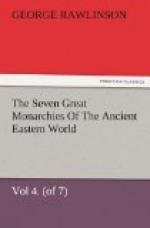In the adjoining country of Susiana, or at any rate in the alluvial portion of it, the principal products of the earth seem to have been nearly the same as in Babylonia, while the fecundity of the soil was but little less. Wheat and barley returned to the sower a hundred or even two hundred fold. The date-palm grew plentifully, more especially in the vicinity of the towns. Other trees also were common, as probably konars, acacias, and poplars, which are still found scattered in tolerable abundance over the plain country. The neighboring mountains could furnish good timber of various kinds; but it appears that the palm was the tree chiefly used for building. If we may judge the past by the present, we may further suppose that Susiana produced fruits in abundance; for modern travellers tell us that there is not a fruit known in Persia which does not thrive in the province of Khuzistan.
Along the Euphrates valley to a considerable distance—at least as far as Anah (or Hena)—the character of the country resembles that of Babylonia and Susiana, and the products cannot have been very different. About Anah the date-palm begins to fail, and the olive first makes its appearance. Further up a chief fruit is the mulberry. Still higher, in northern Mesopotamia, the mulberry is comparatively rare, but its place is supplied by the walnut, the vine, and the pistachio-nut. This district produces also good crops of grain, and grows oranges, pomegranates, and the commoner kinds of fruit abundantly.
Across the Euphrates, in Northern Syria, the country is less suited for grain crops; but trees and shrubs of all kinds grow luxuriantly, the pasture is excellent, and much of the land is well adapted for the growth of cotton. The Assyrian kings cut timber frequently in this tract; and here are found at the present day enormous planes, thick forests of oak, pine, and ilex, walnuts, willows, poplars, ash-trees, birches, larches, and the carob or locust tree. Among wild shrubs are the oleander with its ruddy blossoms, the myrtle, the bay, the arbutus, the clematis, the juniper, and the honeysuckle; among cultivated fruit-trees, the orange, the pomegranate, the pistachio-nut, the vine, the mulberry, and the olive. The adis, an excellent pea, and the Lycoperdon, or wild potato, grow in the neighborhood of Aleppo. The castor-oil plant is cultivated in the plain of Edlib. Melons, cucumbers, and most of the ordinary vegetables are produced in abundance and of good quality everywhere.
In Southern Syria and Palestine most of the same forms of vegetation occur, with several others of quite a new character. These are due either to the change of latitude, or to the tropical heat of the Jordan and Dead Sea valley, or finally to the high elevation of Hermon, Lebanon, and Anti-Lebanon. The date-palm fringes the Syrian shore as high as Beyrut, and formerly flourished in the Jordan valley, where, however, it is not now seen, except in a few




